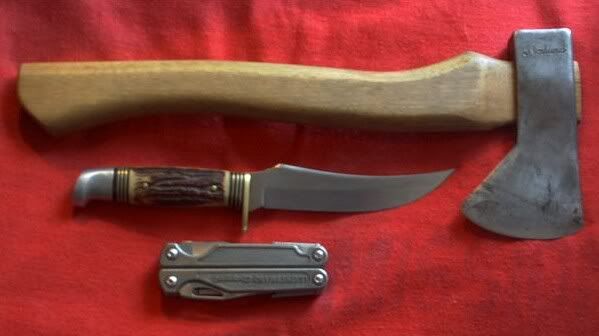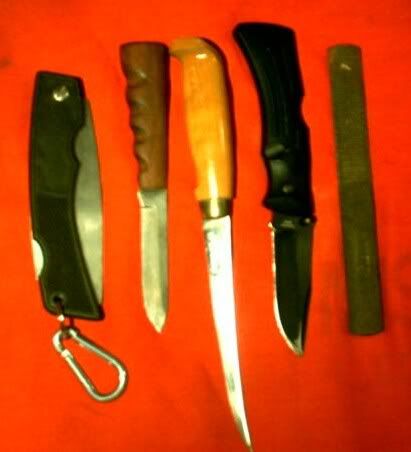Personal likes and dislikes have a lot to do with some of the responses I've seen here. Everyone has their own opinion and experiences, so I'm sharing mine and maybe some can glean something from it.
I'm not knocking anyone's skill here, some of the people here are quite skilled in a lot of crafts, and I seriously respect that.
Myself, I've been doing this for a while, and having grown up with the mountains in my front yard and the desert in my back yard, and more open land to roam in than the entire size of some European countries, I think my perspective on some of these things may be a tad different.
Over here people often do many of the same things you do in this genre as far as the arts and crafts stuff. A focus on arts and crafts are good to a point, and there are many here who do fine work like that.
But, I do think that over here a larger percentage of us approach this genre from a more 'survivalist' viewpoint. Most of us over here I think are a tad more focused on the 'staying fed while in the wilderness' part of bushcraft than the arts and crafts part. IMHO, all of the woodcarving in the world will do you no good if you starve to death, and that's usually the way the Indians saw it too.
So, what we have here is a decision on what is your first priority if you have to actually live for an extended period in the wilderness? Carve wood or stay fed?
Personally, between a Leatherman, a hatchet, and a hunting knife (or previous equivalents I've owned) I've never had a problem with any field task from making traps to cleaning fish, to dressing out a deer, to harvesting cactus fruit.
My personal philosophy is that when you are seriously remote, always have a backup blade and/or extra knives/tools, it isn't a contest to see what you can get done with the least. This is also the what those on the old frontier used to do.
These extras I often keep in my 'kit' when I'm packing extra gear usually includes a selection from a variety different tools such my puukko style patch knife, my Mule lockblade, my Rapala filet knife, a folding saw, and my '4 in Hand'. In the desert I'll often keep the 6" Rapala filet knife clipped to my belt instead of it being in my gear. In the Sonora Desert the 6" Rapala filet knife is one of the best knives you can have for harvesting edible plants.
Here's a selection of various tools I might pack nowadays in with my 'kit' if I'm bringing much extra gear.
For example, my puukko style patch knife I made, often used as my 'neck knife', has a 0170-6C blade of a style and dimensions relatively similar to Mear's $450 potato peeler, though the handle is different.
Here's a photo my homemade puukko with the fresh sheath I have for it.
For shaping wood out in the boondocks or even at home I'll use a Nicholson '4 in Hand' file. THAT will shape wood faster than any knife. Oddly enough, I was doing this for years before I heard that Tom Brown Jr. was also doing something similar for shaping wood.
Most of this stuff is opinion, because if you can get it done with one favorite tool or another, then do it. There are many techniques and approaches to use for most of the different tasks that need to be done.
Even amongst the N. American Indians there was seldom, if any, one single, uniformly accepted way of doing virtually anything. Every tribe had their own ways of doing various things. These differences were pronounced enough that simple things such as the way a man tended to hold and released his bowstring provided clues as to which tribe was related to which.
Hoodoo said:
Personally I don't think the Woodlore is the ideal all rounder outdoors knife. Not all that great for cleaning fish or butchering but it will do. I agree that the thinner bladed mora's are more effective for that and are also great for woodcraft. The woodlore takes a baton well though, which might be a key to it's popularity for bushcraft and the Scandi grind is a far better grind for woodcraft than the Vanguard. No comparison, imo.
I disagree with you on the Vanguard, but I do agree on the Cold Steel Master Hunter, it's one of the few Cold Steel knives I like and I've been eyeing the 'San Mai' version of the blade. If I had to chose between a Mora or a Vanguard, I'd chose the Vanguard, even if it was the 420HC blade.
As for the bone handled knives, that's a matter of preference, I don't find bone or stag handles uncomfortable, if they are rounded, and IMHO they provide a good grip. When they are squared off scales instead of a rounded handle I'll try and change them or use something different. The 5" Western knife I use a lot and just made a new sheath for has a very similar handle to the Marbles plainsman I linked to with that photo.
British Red said:
Mrostov,
Well, actually most hunter gatherer societies uxeisted predominantly on gathering - up to 80% of their food sources were vegetable based. I acknowledge the use and utility of animal foodstuffs but they are just one of many food sources - variety and flexibility are the hallmarks of the man who eats well - according to the seasons, terrain, climate and availability
Well, that mainly depends upon the hunter-gatherer people and where they were at. In most of what is now the US and Canada, the native peoples that got that much of their food from plants were mostly the settled, stationary, farming Indians, not the hunter-gatherer nomads.
There's very few environments outside of the tropics where you can gather enough wild plant food to comprise most of your yearly diet without some agriculture. The Sonora Desert that spans much of the southern half of Arizona and extends down into parts of Mexico is one of those few exceptions, but the Indians even there were still farmers, some of them with extensive canal networks.
Red, though I defended the viability of the bowie in that thread a while back, unlike many of the boonie rats on this side of the pond I really don't use a bowie much, though I am quite familiar with them and their use.
I mainly use a hatchet and a smaller knife (4" to 5" sheath knife with a guard or a 3-3/4" lockblade). That bowie I worked on which I showed pictures of I still like, and I have a friend trying to talk me out of it. Most of bigger knives I've used in the last few years has been with one of my Nepalese made khukuris or my 18" US military machete. If I buy another bowie or large sheath knife, it'll probably be a either a Fallkniven Thor or a Marbles Trailmaker, both of which have 10" blades, which is about 1" longer than that Western Bowie I have.
I think what got some people confused in that thread is that they thought that I said that you can't use a 4" knife. What I stated was that IMHO, your PRIMARY wilderness blade, when you are seriously going to be remote, should be either a large knife, a hatchet, or an axe, but you should probably also have a smaller knife of some sort handy. It's not that you can't do things like make a shelter with a small 4" knife - eventually - but it's a matter of speed, efficiency, and conservation of calories.
If I had to ditch all of my gear and was allowed ONE blade to have as I escaped into the N. American wilderness on a trek of who knows how long, the blade I would chose to bring would NOT be my hunting knife or my bowie or my multi-tool, it would be my Norlund hatchet without a 2nd thought. That one tool gives me a hatchet, a hammer, and an ulu knife. It's also a really good weapon.
If I was allowed a 2nd tool, then it would be my Leatherman. My 5" Western sheath knife would be 3rd priority. My 4th priority? Probably my Gerber folding saw followed by my '4 in Hand'.
As for a handguard or fingerguard 'getting in the way', personally, I don't find the guard in the way. In fact, I find it quite useful on gripping and holding, leverage point, etc. If you have used a knife like that all of your life, you get used to having the guard. I look upon the guard as a plus from many aspects, not something that's in the way, and a fingerguard, like the one on my 5" Western isn't that big, IMHO.
The first time someone cuts the blazes out of themselves when they are gutting a larger animal like a deer or a sheep, they'll know what I mean. Most of the experienced people that I've seen slice themselves open pretty good while doing such stuff have been using knives with minimal fingerguards, like a Buck 110.
When I was a kid in the 70's in rural America almost every local it seemed had a Buck 110 (3-3/4") or a Buck 112 (3") on their belt. I wore a Buck 112 and as I got older a Buck 110 on my belt at school and no one thought it the least bit unusual.
Buck 110's seldom 'fail' as in the knife closing on your hand while you are using it after it has locked open. That is extremely rare and usually the knife has to be ridiculously filthy or badly damaged and/or abused. But, I have seen numerous times when someone who normally knew what they were doing, with slippery hands and a slippery 110, well, slips, and voila, since they are usually razor sharp, then you have an injury. It's like that Woodslore knife. You may be able to get away with gutting and butchering several animals with it, but if you do it enough it will eventually bite you and hopefully you're not in a survival situation when it does.
Now, I know in Britain you don't have the vast array of wild game that we do, but you do have game animals, including some types of deer. The whole point that people shouldn't lose sight of is that these skills are meant to be used for real, and some day you may have to do just that, whether it's gutting a deer/goat/sheep in the countryside or gutting a more mundane food source after some calamity, like maybe a dog or something (btw, boiled puppy was considered quite the culinary treat by the Indians).
















